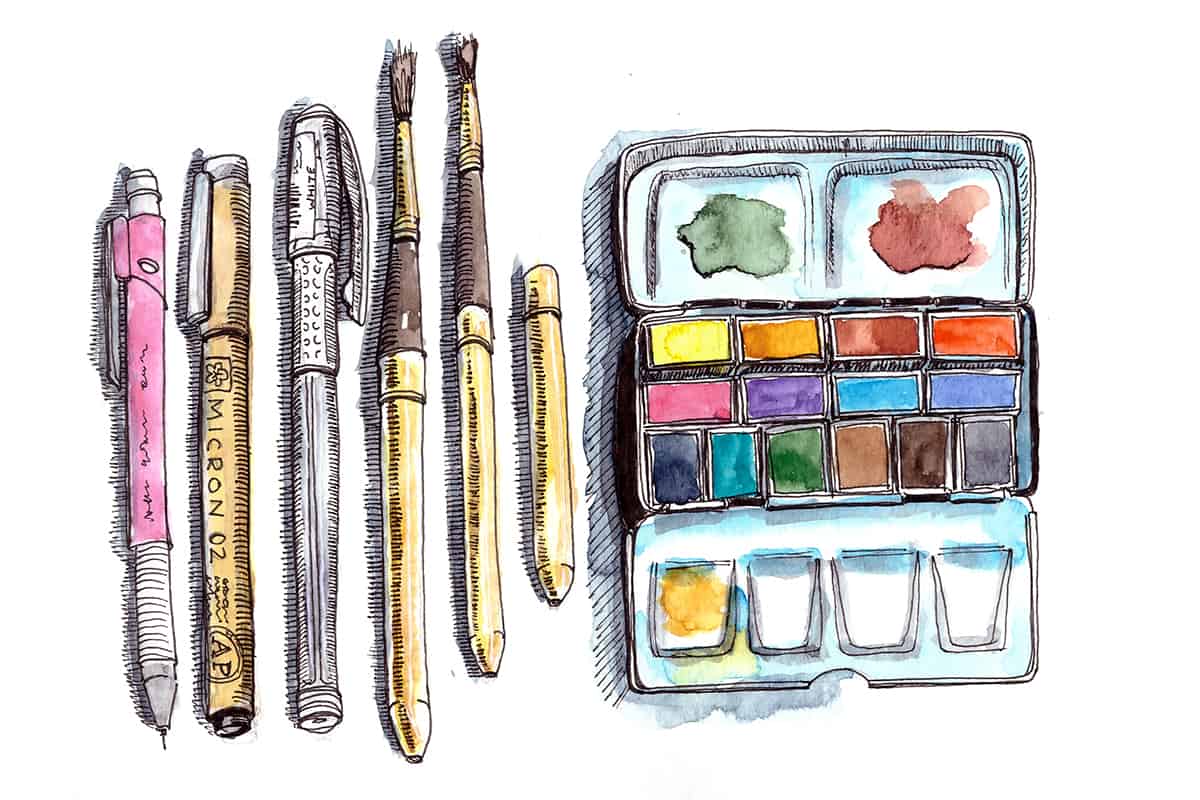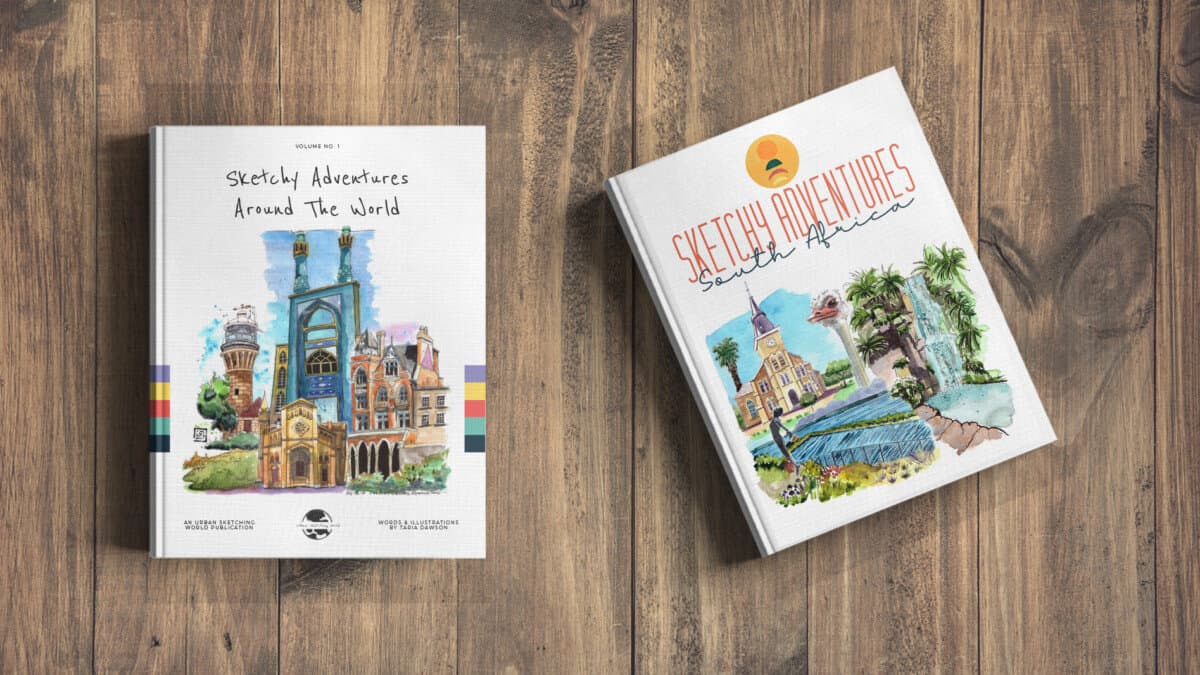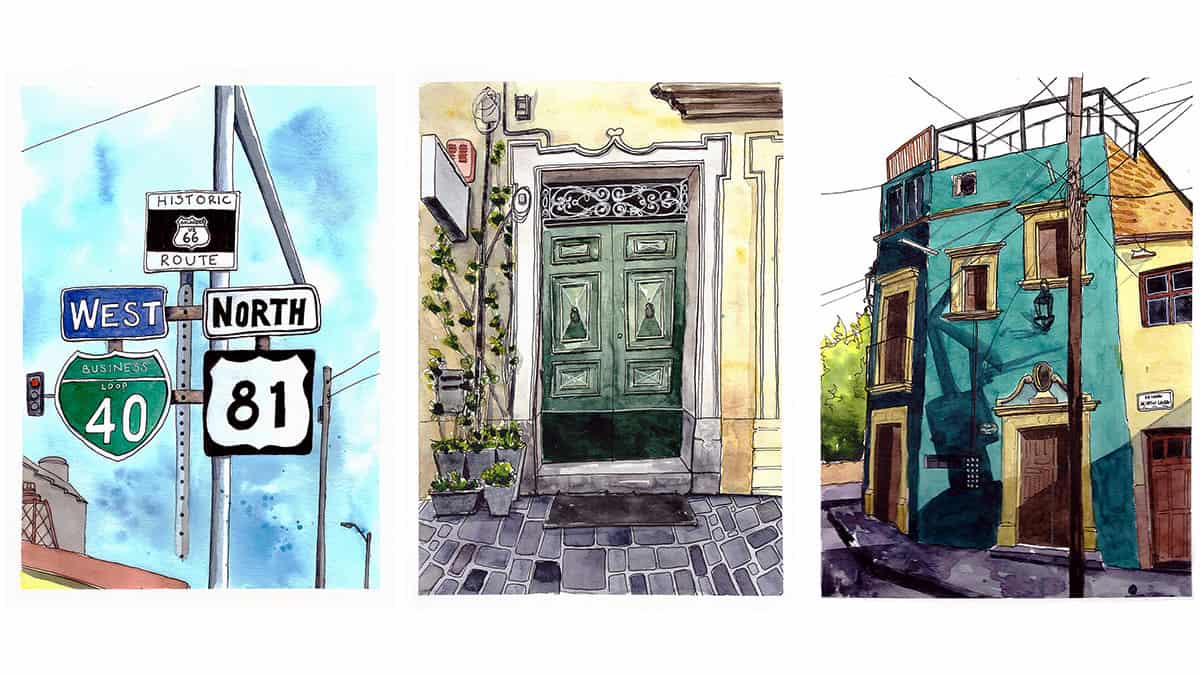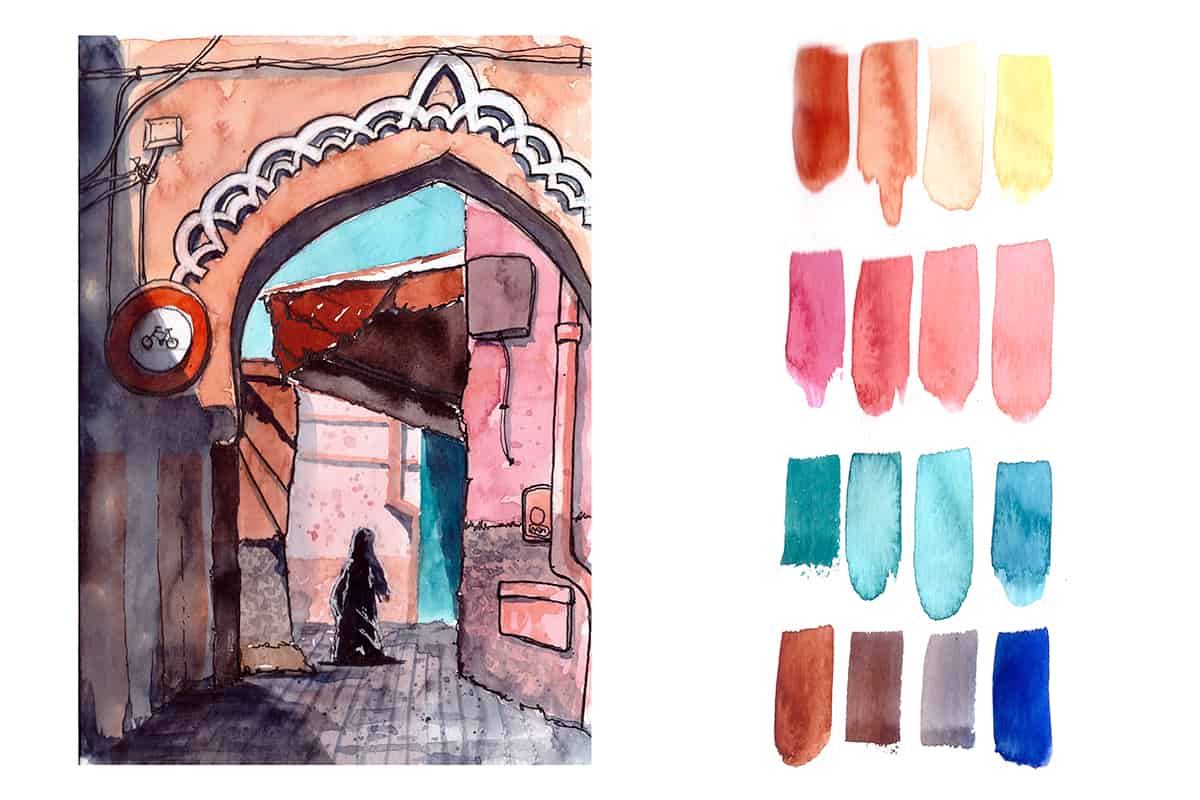This post will cover some of the most important tips and tricks to know when it comes to urban sketching. Learning, developing and keeping in mind some of the factors below will help you leapfrog quite a bit of the learning curve when it comes to taking your sketching skills to the streets…or just the outside world in general.
There is much information available to us these days that it’s easy to get lost in the noise and never really get a clear handle on what the essential points are.
With this list of tips, I hope I can give you some concise advice on becoming a better urban sketcher.
The Secrets to Becoming a Better Urban Sketcher
Keep It Simple
I cannot emphasise this enough, especially if you are just starting out. Having too many supplies to choose from is (a) going to be annoying to carry around and (b) cause decision fatigue i.e. you will spend so much time wondering which pen to use, which brush to use or what colour to select that you won’t leave yourself enough time to do the actual fun part – sketching.

Consider a minimal sketch kit such as:
- pencil
- 2 x pens: one fine line and one with thick line e.g. 0.2 and 0.7
- 2 x brushes: one small and one large
- watercolour sketchbook
- watercolour paints
If you want more information on the best urban sketching supplies, check out these posts:
Best Sketchbooks for Urban Sketching
Best Watercolour Sets for Urban Sketching
Best Watercolour Brushes for Urban Sketching
My Urban Sketching Travel Kit 2020
Be Prepared
I think you may have heard everyone say this before BUT carry your sketchbook everywhere! People say it a lot because it’s really important. You never know when you may be stuck waiting for something or have some unexpected time on your hands or see something you really want to sketch. It can be simple as carrying an A6 (3ish x 5ish inches) sketchbook and a ballpoint pen in your pocket or bag.
Ian Sidaway creates fantastic drawings of trees in his little pocket sketchbook with a simple fineliner. That’s really all it takes.
This means you can practice everywhere, you’ll never be bored again and with simple materials (as we discussed above) you won’t overcomplicate matters.
I like the little Stillman & Birn Alpha 3.5 x 5.5 inch softcover book which you can find on Amazon. It can handle light watercolour too if you do decide to take a small box of paints out with you.
For more information on my favourite urban sketching supplies, check out my video below!
Create Depth
Creating depth will always add the WOW factor to your sketches.
You can create depth in a variety of ways:
- painting shadows and leaving the white of the page for highlights
- using different weight ink lines
- painting things in the foreground with more intensity than things in the background
- paying close attention to perspective
I love the depth Rob Sketcherman achieves in his sketch above. He uses darker thicker lines and lots of details in the boat in the foreground and simply hints at the buildings in the background with much less detail, light grey shapes and no dark outlines.
Take your urban sketching skills to the next level with these awesome Domestika classes:
Urban Sketching: Express Your World in a New Perspective with Lapin
Artistic Watercolour Sketching: Dare to Sketch with Felix Scheinburger
Watercolor Travel Journal with Alicia Aradilla
Storytelling
The power of storytelling cannot be underestimated. People will connect with your sketch in an instant if it’s telling a story.
How do you tell a story with your sketch?
- Show action
- overlapping elements
- showing the passage of time
- making notes around the sketch
- creating a sequence of events.
For more on the art of visual storytelling and reportage illustration, check out my post here.
I love how Lapin uses speech bubbles to capture what his subjects utter while he draws, a really beautiful way to tell a story.
Check out my ebooks with hundreds of ink & watercolour travel sketches from all over the world. Get some inspiration for your next trip…

Contrast
The difference between the darkest darks and the lightest lights to create an impact. If your sketch appears to be the same value throughout, there will no sense of depth or drama. Your sketch will look flat and dull. This leads me on to my next point…
Work in Layers
For watercolour to look super vibrant you often need to apply it in layers. Watercolour dries lighter than when you apply it, so even if you think you have applied something far too dark, give it a minute or two and you may be pleasantly surprised. Many beginners sketches can look flat, this is generally because only one weak layer of watercolour had been applied and no sense of light and shadow has been created.
Do you want to learn how to sketch your own adventures in ink & watercolour?
GET 50% OFF FOR A LIMITED TIME ONLY!!
I will show you my exact sketching process in ink and watercolour. I have travelled around the world in the last 3 years and this is my go-to system of creating beautiful yet quirky illustrations to capture the magic of my discoveries.
We will work through 3 projects, step by step (pictured below), all of which are real-life examples of things I have sketched along my travels. I provide the photo references you can work from.
We will start by choosing a composition, laying in the initial pencil sketch, adding ink lines, layering watercolour and adding the final touches.
This and much more are included in my course, Sketch Your Adventures, click the button under the image to find out more!

Perspective
Capturing the correct perspective of a scene helps to create an accurate representation as well as a sense of depth, for example, elements getting smaller as they recede into the background.
Perspective can also be used as an element of storytelling. Try and think of scenes in a movie and the angles a camera may capture the action from. Shifting perspectives to capture something high above or below can add a sense of drama.
Style
Sometimes I feel I have found my style and other times I still experiment widely with other styles. And that’s ok. In fact, I think it’s advisable to do this.
precise details with neat linework or loose and scribbly? Splashes of watercolour or a complete painting. Look at the work of other urban sketchers and experiment with different styles.
If you’d like to read more about various urban sketching styles check out this post. If you’re interested in how I found my urban sketching style, check out this post.
Urban sketcher, Ian Fennelly, has a super distinctive yet consistent style. I think when you become a full-time professional artist (such as Ian) it makes sense to have your own style which you don’t really deviate from. However, we mere mortals should continue to play and experiment with our styles as much as possible (I feel).
Colour
Colour is a vital piece of your sketchy puzzle. I’m all too experienced in producing a sketch I was happy with only to then ruin it by applying colour incorrectly.
Verse yourself on basic colour theory and use a limited colour palette. Stripping your colour choices back to 3-5 can really help you avoid a muddy or unintentionally muted result.
Also, think about the story you are telling through your colour choices, are you using bright and vibrant colours or do you want a more delicate and muted vibe? Perhaps you want to use a monochrome scheme (different values of one colour)? Or a monochrome scheme with one accent colour, for example, shades of grey but with a pop of red.
There are so many factors to consider when using colour. Try to keep it simple at first and then as you become more confident, experiment with different concepts and schemes.
To read my full post on colour theory click here, this includes using limited palettes and making your own watercolour mixing chart. I also have a few videos on the subject over on my Youtube channel.
Detail
Deciding on how much detail to include in your sketch is another way to control the narrative as well as make stylistic choices.
I really love the effect of leaving certain parts of a sketch either unfinished or unpainted. I find this technique beautiful and captivating.
Leaving some parts of the sketch unfinished lets the viewer fill in the blanks. It somehow involves the viewer becoming an active participant in the sketch – if you know what I mean?! It’s like when an author hints at certain things but leaves parts unsaid throughout a novel, with the reader having to make inferences.
Check out my post on examples of the line and wash technique for further inspiration.
Some of my favourite online classes
- Watercolor Portrait Sketchbook – Carlos Rodriguez Casado
- Expressive Architectural Sketching with Colored Markers – Albert Kiefer
- Experimental Watercolour Techniques For Beginners – Ana Santos
- Urban Sketching: Express Your World in a New Perspective – Lapin
Impose Limitations
Create challenges for yourself, I always find imposing limitations on myself really fun. You can use limitations each time you go out to sketch or for a certain time period, i.e. a week.
Examples of such limitations could be:
- drawing only in pen
- using watercolour first and drawing on top of it
- Using a limited palette of 3 colours
- drawing on toned paper
- Using a different medium entirely – if you use watercolour usually then use markers, pastels or colour pencils and vice versa
You can also impose limitations regarding your subject matter:
- Only draw people
- Only draw architecture
- Only draw plants/trees etc.
- Only draw street furniture (benches, lamposts, postboxes, fire hydrants etc)
- Only draw vehicles (cars, motorbikes, buses, etc)
These limitations can be really fun. You could fill an entire sketchbook, or at least a few pages with a theme. This can really help you push outside of your creative boundaries and you may discover some new aspects to your sketching along the way.
Check out this amazing sketch on toned paper by @dy.chent
Final Thoughts
I hope these tips and tricks have helped you to consider the multiple aspects of urban sketching to experiment with. Most of all I hope I have inspired you to play.
If you’d like some recommendations of urban sketching books then check out this post.
If you like this post then please join my newsletter where I discuss all things urban sketching. I only email once a week maximum! Pop your email address in the box below.

